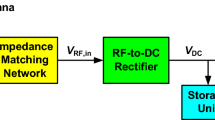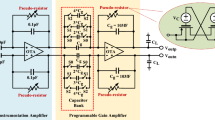Abstract
The linearity and noise requirements in multi-band multi-standard applications make the design of RF CMOS circuits a very challenging task. A low noise transconductance amplifier (LNTA) in 130 nm CMOS technology that operates between 1 and 6 GHz is presented. The LNTA is based on a shunt-feedback (SFB) amplifier with current-reuse scheme and employing the noise-canceling technique used in low-noise amplifier designs for wideband input matching. Two versions of the LNTA were designed in a 130 nm CMOS process and occupy 0.038 and 0.014 mm2 of silicon area while consuming just 9.1 and 7.94 mW, respectively. The second version is an inductorless, smaller, and optimized version of the first one. Post-layout simulations in the temperature range of −40 to 125 °C show a good trade-off between noise and power-consumption across the frequency span with an average noise figure of 3.8 dB and a minimum transconductance of 41.5 mS over the entire band. Performance variations were estimated at 2 GHz with Monte Carlo analysis.










Similar content being viewed by others
References
Abidi, A. (2007). The path to the software-defined radio receiver. IEEE Journal of Solid-State Circuits, 42(5), 954–966. doi:10.1109/JSSC.2007.894307.
Bae, J. Y., Kim, S., Cho, H. S., Lee, I. Y., Ha, D., & Lee, S. G. (2013). A CMOS wideband highly linear low-noise amplifier for digital TV applications. IEEE Transactions on Microwave Theory and Techniques, 61(10), 3700–3711. doi:10.1109/TMTT.2013.2278156.
Blaakmeer, S., Klumperink, E., Leenaerts, D., & Nauta, B. (2008). Wideband Balun-LNA with simultaneous output balancing, noise-canceling and distortion-canceling. IEEE Journal of Solid-State Circuits, 43(6), 1341–1350. doi:10.1109/JSSC.2008.922736.
Bruccoleri, F., Klumperink, E., & Nauta, B. (2004). Wide-band CMOS low-noise amplifier exploiting thermal noise canceling. IEEE Journal of Solid-State Circuits, 39(2), 275–282. doi:10.1109/JSSC.2003.821786.
Chen, K. H., & Liu, S. I. (2012). Inductorless wideband CMOS low-noise amplifiers using noise-canceling technique. IEEE Transactions on Circuits and Systems I: Regular Papers, 59(2), 305–314. doi:10.1109/TCSI.2011.2162461.
Cordova, D., Toledo, P., Klimach, H., Bampi, S., & Fabris, E. (2016) A 90 dB PSRR, 4 dBm EMI resistant MOSFET-only voltage reference. In: 2016 IEEE 7th Latin American Symposium on Circuits Systems (LASCAS), pp. 1–4.
Fiorelli, R., Villegas, A., Peralías, E., Vazquez, D., & Rueda, A. (2011) 2.4-GHz single-ended input low-power low-voltage active front-end for ZigBee applications in 90 nm CMOS. In: Proceedings of the 2011 20th European Conference on Circuit Theory and Design (ECCTD), pp. 829–832, DOI 10.1109/ECCTD.2011.6043831
Fiorelli, R., Silveira, F., & Peralias, E. (2014) MOST moderate-weak-inversion region as the optimum design zone for CMOS 2.4-GHz CS-LNAs. IEEE Transactions on Microwave Theory and Techniques 62(3):556–566. doi:10.1109/TMTT.2014.2303476
Ho, S., & Saavedra, C. (2010). A CMOS broadband low-noise mixer with noise cancellation. IEEE Transactions on Microwave Theory and Techniques, 58(5), 1126–1132. doi:10.1109/TMTT.2010.2045568.
Ru, Z., Moseley, N., Klumperink, E., & Nauta, B. (2009). Digitally enhanced software-defined radio receiver robust to out-of-band interference. IEEE Journal of Solid-State Circuits, 44(12), 3359–3375. doi:10.1109/JSSC.2009.2032272.
Silveira, F., Flandre, D., & Jespers, P. G. A. (1996). A gm/ID based methodology for the design of CMOS analog circuits and its application to the synthesis of a silicon-on-insulator micropower OTA. IEEE Journal of Solid-State Circuits, 31(9), 1314–1319. doi:10.1109/4.535416.
Acknowledgments
This work was partially supported by CNPq, CAPES and by IC-Brazil Program and MOSIS for access to chip fabrication services.
Author information
Authors and Affiliations
Corresponding author
Rights and permissions
About this article
Cite this article
Cordova, D., Bampi, S. & Fabris, E. A CMOS low noise transconductance amplifier for 1–6 GHz bands. Analog Integr Circ Sig Process 89, 585–592 (2016). https://doi.org/10.1007/s10470-016-0802-5
Received:
Revised:
Accepted:
Published:
Issue Date:
DOI: https://doi.org/10.1007/s10470-016-0802-5




